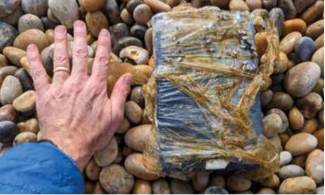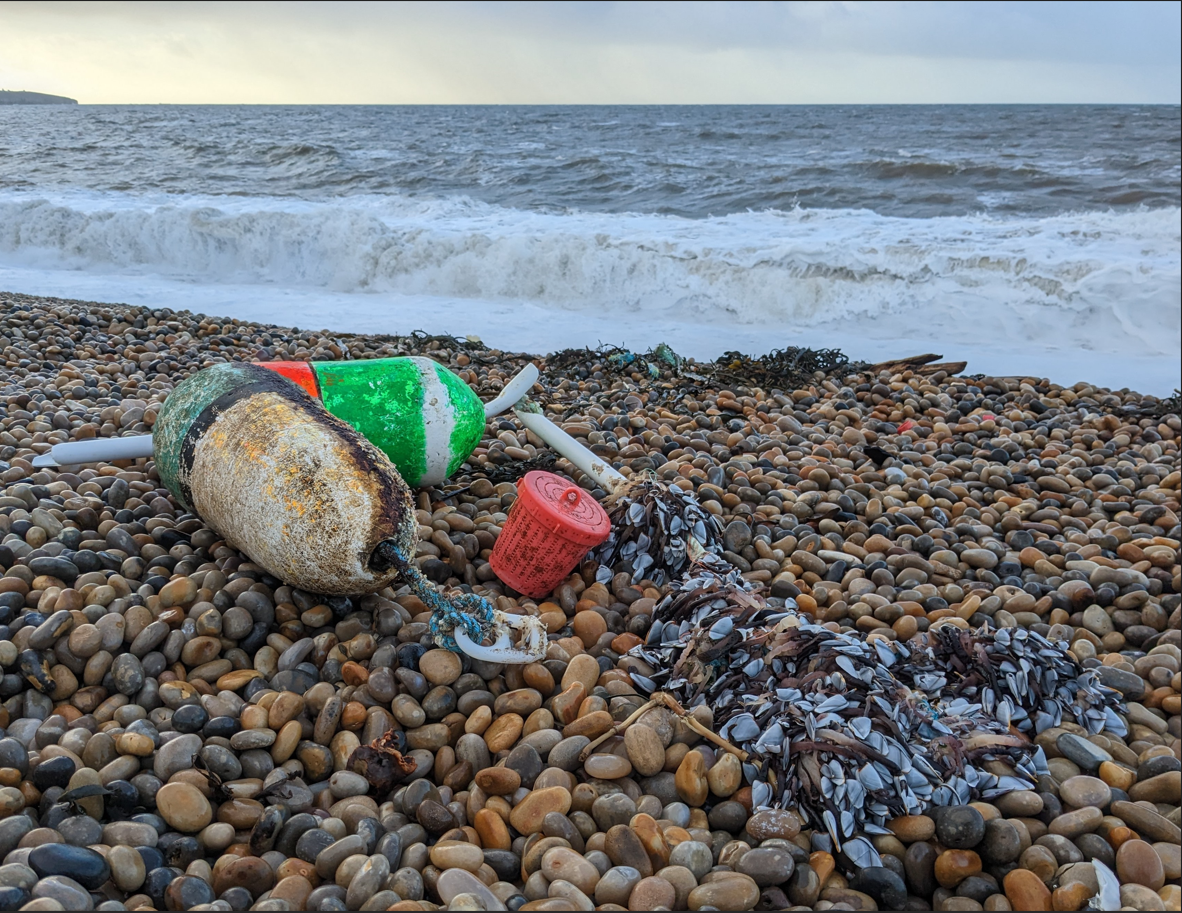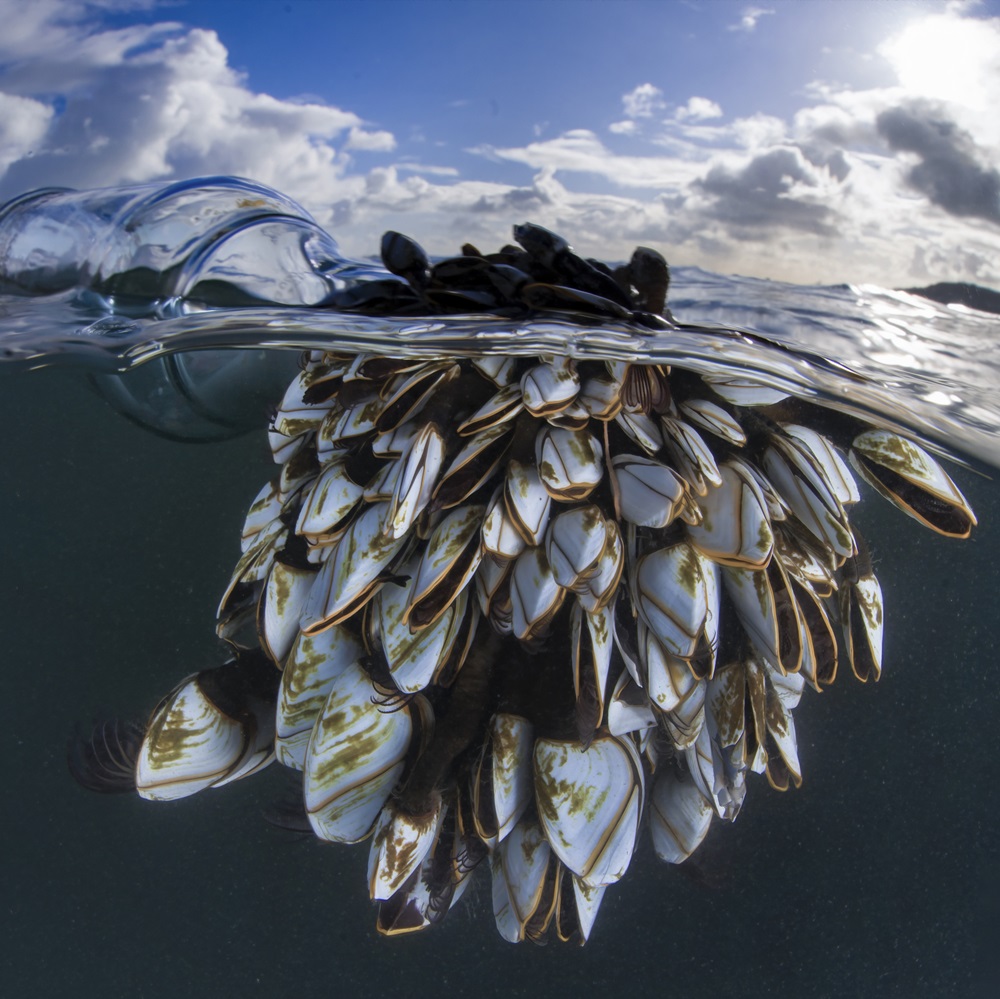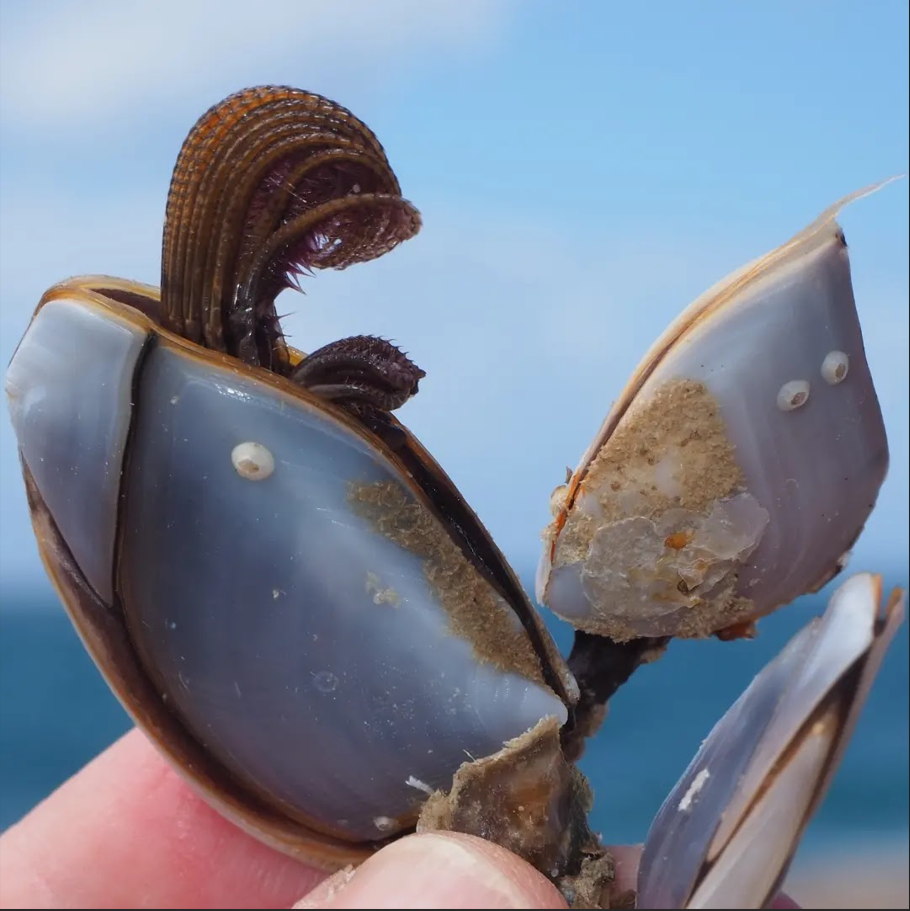It's not every day you find a kilogram of cocaine with an estimated street value of £70K washed up on your local beach; however, that's exactly what I did find on Chesil Beach on 1st April 2023. But this small, sad-looking rectangular package wrappd in several layers of cellophane, slightly torn and beginning to unravel (Fig.1), was no April Fool's joke.

Figure 1. The package of cocaine found by the author on Chesil Beach, bearing small Lepas anatifera goose barnacles.
I should stress I do not beachcomb in the hope of finding nefarious packages, but to look for far more interesting things, namely goose barnacles and other pelagic critters. For that very reason, my eye was drawn to the package: a few tiny Lepas anatifera were attached to the now loosening cellophane. These goose barnacles began life as free-swimming larvae, circulating in the ocean currents until they happened upon the package. They each attached themselves to the slippery wrapper with their stalk-like peduncle by secreting one of the most powerful adhesives known in nature. I quickly scoured the strandline for any further parcels but finding none, tucked the package under my arm and headed home. On informing the police, they arrived at the house within 10 minutes, blue lights, and all! The friendly police officer informed me of the cocaine’s estimated street value, assured me it would not be used at their Christmas party, and left with a broad grin, having what I would guess for him was a good day at the office. I wondered if any other packages had recently washed up along the south coast, but a quick Google search proved fruitless. However, something far more intriguing popped up in the guise of an article in The Guardian newspaper. The article, dated June 2021, described a stranding of 24 packages, identical to mine, in Cape Canaveral, Florida. I regularly collect flotsam from as far away as the Caribbean and the east coast of North America and Canada and washed up alongside the cocaine there had been some items from the other side of the Atlantic, namely a buoy from Florida and a bait pot also from the US (see Fig. 2).

Figure 2. Goose barnacles (Lepas anatifera) on flotsam found near the cocaine.
So, I knew it wasn’t beyond the realms of possibility that my package could have drifted across the Atlantic in the previous 22 months. By now, my curiosity was well and truly fired and I wondered if the goose barnacles might be the key to solving this mystery.
Whenever I discover something interesting or have a marine related question, I email Dr Lin Baldock, who can be relied upon to provide intriguing information and interesting leads. True to form, she sent me links to two articles. In his 1958 paper, Frank Evans referred to a letter by Stanley Kemp to J.F. Anton, in which Kemp gave minimum growth rates of goose barnacles from three sources: first, an increase in capitulum length1 of about 1 mm a day for Lepas spp.; the second and third, referring to L. anserifera, gave increases of 8 mm in 8 days, 21 mm in 40 days, and 25 mm in 107 days. Stanley Kemp happened to be Lin’s grandfather, a marine biologist and crustacean expert.
The second paper, titled ‘Evaluation of the floating time of a corpse found in the marine environment using the barnacle Lepas anatifera’ and published in Forensic Science International, was extremely interesting, if a little macabre. The paper described an attempt to determine the length of time a badly decomposed corpse had been adrift in the Tyrrhenian Sea, after washing ashore in May 2012 in the Calabria region of south-west Italy. The man’s trousers and the soles of his shoes were colonised by small Lepas anatifera with a maximum capitulum length of 12 mm. It was these small barnacles, which inhabit both tropical and temperate seas around the world, that provided clues to the length of time the man had been adrift and, therefore, the time of his death.
There are many factors, biological and physical, that affect growth rates of Lepas spp., but temperature is the most important variable. Due to relatively limited research on growth rates of Lepas spp., the team of scientists used growth measurements taken from a mooring in the eastern tropical Pacific Ocean, where sea surface temperature (SST) ranged from 26.5°C to 30°C. Measurements were taken from large specimens with capitulum lengths over 42 mm for Lepas anatifera, with approximate mean growth rates of 0.36 mm to 0.48 mm/day. Data supplied by the Italian Navy’s Hydrographic Institute showed average SSTs for the Tyrrhenian Sea fluctuating between 13°C and 19°C between January and May. Using this information, the scientists were able to estimate the minimum length of time the corpse had been afloat. Due to the lower temperatures in the Tyrrhenian Sea in comparison to the tropical Pacific Ocean, the slowest capitulum growth rate of 0.2 mm per day was used. At this rate, it would take Lepas anatifera approximately 60 days to reach a capitulum length of 12 mm. Other factors, such as the length of time it takes the larval stage of the barnacle to attach itself to a substrate, also had to be considered. Laboratory experiments suggest a larval attachment phase of 5 days, but at a much warmer temperature of 24°C. These nuggets of information enabled the research team to estimate the length of time the corpse had been afloat and to provide the pathologist with a minimum period of 65 days since the man’s untimely demise. Using this information and taking into account North Atlantic SSTs for February to April, I concluded, rather crudely, that my cocaine package hosting Lepas anatifera had been afloat for at least 60 days. Did this quash the idea that it may have come from the same batch in Florida 22 months beforehand? Perhaps not; it is possible that some larger Lepas anatifera had fallen off when the outer cellophane became loose, and that these smaller barnacles had recolonized the package more recently, or that substrates like cellophane take much longer to be colonized by Lepas barnacles than others, and my little package did indeed cross the Atlantic.
The mystery of flight MH370
A few months later, a National Geographic article appeared on my news feed and sparked my overactive imagination once again. A team of scientists from around the world, led by Gregory Herbert, a marine ecologist from the University of South Florida, have been using Lepas anatifera to try and narrow down the search area for the Malaysia Airlines flight MH370 that mysteriously disappeared somewhere in the Indian Ocean in 2014, along with 239 passengers and crew.
In 2015 a flaperon (a critical component for take-off and landing) from the wing of the doomed aircraft was washed ashore on Reunion Island in the western Indian ocean, encrusted in Lepas barnacles. Herbert and colleagues have created a statistical methodology that can precisely track sea SST using temperature data from satellite-tracked drift buoys that are deployed throughout the global ocean. The ‘7th Arc’ is a line of possible positions of flight MH370 before the aircraft finally ran out of fuel and crashed into the eastern Indian Ocean. Combining SST data with the 7th Arc, it may be possible, with the help of experts in ocean drift modelling, geospatial statisticians, and geochemists—along with the most crucial player of all, the Lepas barnacles themselves—to potentially determine with more accuracy the search corridor for the missing aircraft.
Calculated from the final radio signals of flight MH370, the 7th Arc extends from the eastern Indian ocean, somewhere south of the Indonesian Island of Java, towards Antarctica. To shrink down this enormous area, it would be necessary to extract SST data from the capitula of the Lepas barnacles. To do this, Herbert would need a barnacle expert, so he reached out to Dr Anne Marie Power at the Ryan Institute, University of Galway. Dr Power set up an experiment in which Lepas anatifera were raised under three temperature regimes (14, 20, and 24°C). Other parameters, such as salinity, light, and feeding, were all kept constant for the 3-week duration of the experiment, and evaporation was kept to a minimum to control the oxygen isotopic composition of each aquarium. The conclusion of Dr Power’s work is that it is possible to determine the water temperature history down to 0.1°C through the ratio of oxygen isotopes within each layer of calcite laid down within a barnacle’s capitulum. It is these oxygen isotope ratios at known SSTs that could provide the clues to the drift path and origin of the wreckage from aircraft MH370.
Dr Power said, ‘We are now planning some detailed sclerochronology of Lepas barnacles to see if they lay down daily age rings. The barnacles will be immersed in a chemical tag to mark the point where old growth stops and new growth begins over a known number of days.’ This could provide even more accurate information on the drift time of the flaperon, potentially further narrowing the search area. Such developments may one day lead the Malaysian government to resume their search and bring closure for many families devastated by the disappearance of flight MH370, particularly if the isotopic signatures of the largest flaperon barnacles are ever made public by the French Government. The latter would allow drift to be calculated further back in time, closer to the crash site.
These new integrated scientific approaches can be applied to many other questions, such as tracking plastic ocean debris or human remains, but what interests me is tracking the migratory routes of large marine animals. Using such methodologies on sick turtles laden with goose barnacles, it should be possible to reconstruct drift routes back to geographical areas of infection.
I may not find out where my package of cocaine came from, but I am extremely grateful to Anne Marie Power and Lin Baldock for taking me on a fascinating journey. I will never look at goose barnacles the same way again.
• Craig Pinder (craig_pinder@hotmail.com)
Further reading
Evans, F. 1958. Growth and maturity of the barnacles Lepas hillii and Lepas anatifera. Nature 182, 1245-1246.
Magni, P.A., Venn, C., Aquila, I., Pepe, F., Ricci, P., Di Nunzio, C., et al. 2015. Evaluation of the floating time of a corpse found in a marine environment using the barnacle Lepas anatifera L. (Crustacea: Cirripedia: Pedunculata). Forensic Science International, 247, e6-e10. https://doi.org/10.1016/j.forsciint.2014.11.016
Al‐Qattan, N., Herbert, G.S., Spero, H.J., McCarthy, S., McGeady, R., Tao,R. and Power, A.M. 2023. A stable isotope sclerochronology‐based forensic method for reconstructing debris drift paths With application to the MH370 Crash. AGU Advances, 4, e2023AV000915.

Cover image. Lepas anatifera on bottle


